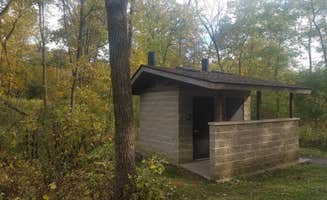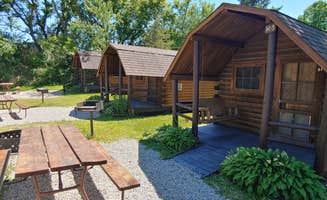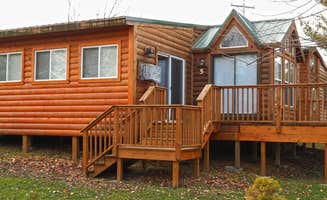Chain O' Lakes State Park, located about 30 miles northwest of Twin Lakes, Wisconsin, sits within the glacial landscape of northeastern Illinois. The interconnected waterways cover 488 acres across 15 lakes, with water depths ranging from 3 to 40 feet. Winter temperatures can drop below 10°F, while summer highs typically reach 80-85°F, making seasonal preparation essential for visitors seeking glamping accommodations near Twin Lakes.
What to do
Kayak through interconnected waterways: At Turner Lake South — Chain O' Lakes State Park, kayakers can explore the extensive lake system. According to one visitor, "There's some small trails around as well that are beginner. There was electricity, however those sites are $25/night" (Addison G.). The lakes offer clear water visibility for wildlife viewing.
Fish from your campsite: Fish Lake Beach Camping Resort provides lakefront tent sites where you can fish directly from your camping area. A camper noted, "The lake is beautiful and surprisingly picturesque as it is all nature preserve on the opposite side. The beach is large enough and there are clean bathrooms right there" (Chloe N.).
Explore trails for all ability levels: The Ottawa Lake Campground connects to numerous hiking paths suitable for families. "The campground was close to our intended hiking trail — the Scuppernong section of the Ice Age Trail. It's absolutely gorgeous and will be why we come back again" (Linda N.).
What campers like
Privacy between sites: At Fox Den Campground, campers appreciate the site layout. "Fox den at Chain-o-Lakes state park provides a more secluded camping experience than Honeysuckle or the 2 tent camping areas. Pads are pretty level, and each site has some semblance of privacy from other campers" (Ian C.).
Clean facilities: The bathroom facilities at several luxury glamping options near Twin Lakes receive positive reviews. "The showers were clean. The spots were large and wooded with nice fire ring set ups. The staff was very helpful answering any questions and giving recommendations" (GoWhereYouAreDraw N.).
Fall camping conditions: Seasonal benefits include fewer crowds and beautiful foliage. At Big Foot Beach State Park, a reviewer mentioned, "Clean sites, Lake Geneva swimming, friendly staff not far from Lake Geneva and stores for food and supplies the fall is beautiful and less crowded" (Belinda R.).
What you should know
Insect preparation is essential: Ticks and mosquitoes are common in this region, especially in wooded camping areas. A camper at Honeysuckle Hollow — Chain O' Lakes State Park warned, "SO many ticks. With a baby crawling that needed to be set free, we were constantly doing checks. They literally fall out of the trees into people! Plan for toddlers and babies to have a contained covered screen house" (Meg).
Wildlife will visit after dark: Raccoons are common nighttime visitors. "The raccoons at night here are no joke. The second it's dusky, they come scavenging for absolutely anything food has touched. So basically, eat dinner and do s'mores early, then everything must be packed into cars for the night" (Meg).
Winter camping options are limited: Most glamping sites near Twin Lakes close between late October and April. The few year-round options include rustic cabins with heating. "No showers in winter but awesome" (David H.) said one winter camper at Ottawa Lake Campground.
Tips for camping with families
Book premium glamping cabins early: Luxury accommodations at Chicago Northwest KOA fill quickly during summer months. "Staff was very friendly and the facilities were kept very clean. Plenty for the little kids to do, and the text message communication was great with regards to weather updates or any goings on around the campground" (Dan B.).
Consider Thursday arrival: For weekend trips to popular glamping destinations near Twin Lakes, Thursday arrival significantly improves site selection. "While these sites are usually slated for walk-ups on the weekends, it seems like a lot of people go early on Thursday or even Wednesday to secure their sites for the weekends" (Marisa A.).
Bring screens for outdoor spaces: Protect children from insects by creating protected outdoor areas. Mesh screen houses placed on tarps with blankets provide safe play zones. "Luckily our screen house pop up on a tarp that was sprayed ahead for tick repellent plus a blanket on top of that did the trick" (Meg).
Tips from RVers
Electric hookup location varies by campground: At Fox Den, each site has an individual electric post, while at Honeysuckle Hollow, the situation differs significantly. "These sites share an electric box. Some spaces the box is further than 30 feet from the pad. A lot of the spaces are also crowded together. Recommend sites 23 to 46 for spacing and electric distance" (Debra M.).
Dump station timing matters: During peak summer weekends, plan extra time for the dump station. "The dump station was near the entrance to the camping loop and had potable water. It was also very busy and we had to wait when filling up and again when dumping" (Tina).
Water access options: Many glamping sites near Twin Lakes offer either partial or full hookups. "We had a back-in site on the north side of the campground. We had 50 amp, but no water/sewer, although there was a water spigot next to our site that we could use to fill up jugs of water" (Tina).




